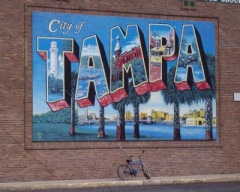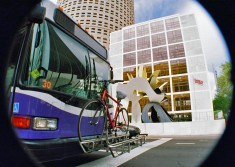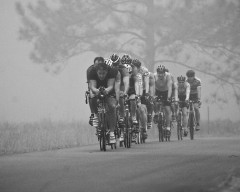Protect your head – always wear a helmet
Never ride a bicycle without a helmet. The National Highway Traffic Safety Administration (NHTSA) and the Consumer Product Safety Commission (CPSC) recommend that cyclists wear a helmet that complies with the CPSC standard. Select a helmet that fits snugly and sits flat on your head.
Bicycle helmets can reduce head injuries by 85 percent.
Make sure your bicycle is proper working order
Before using your bicycle, ensure that all parts are secure and working well. The handlebars should be firmly in place and turn easily. Your wheels must be straight and secure and the brakes MUST be in proper operating condition. If you need to carry things, add a carrier to the back of your bicycle.
Always check the brakes before riding.
Always ride under control. If your bicycle has hand brakes, apply the rear brake before the front brake. Applying the front brake first can literally flip you over your handle bars. Always keep your brakes properly adjusted. If you cannot stop quickly, adjust your brakes. When adjusting brakes, keep the following in mind:
When your hand brake levers are fully applied, they should not touch the handlebars.
Each brake pad should wear evenly and never be separated more than one eighth inch from the rim.
Ride slowly in wet weather and apply your brakes earlier – it takes more distance to stop. Motorists will have a harder time seeing you in the rain, so ride with extra care in inclement weather.
Avoid biking at night
If you must ride in the dark:
Wear reflective clothing or accents – not just white or florescent – especially on your ankles, wrists, back, and helmet.
Ride with reflectors that meet CPSC requirements. If a carrier is added, make sure the rear reflector remains visible.
Add the brightest lights you can find to the front and rear of your bicycle.
Only ride in areas familiar to you. Brightly lit streets are best.
Always assume you are not seen by a driver.
Young children should NEVER ride at night.
Stay alert. Always keep a lookout for obstacles in your path.
Watch out for potholes, cracks, expansion joints, gravel, wet leaves, drainage grates, or anything that could make you fall.
Before going around any object, scan ahead and behind to make sure it’s safe to proceed.
Always signal your intentions, and then do what you planned.
If you are unsure, or lack the skill to handle an especially rough area, pull off to the right side of the road and walk your bicycle around the rough area.
Be especially careful in wet weather.
Cross all railroad tracks at a 90-degree angle and proceed slowly.
Defensive Cycling: A great article and more valuable tips on riding safe
Riding with traffic is the RIGHT way.
Ride on the right side of the road in a straight, predictable path. Always ride single file in the same direction as other vehicles. Riding against traffic makes it difficult for motorists to see you, which makes it easier for them to accidentally pull across your path or into you.
Teach children the rules of the road. Cyclists are responsible for following traffic laws and signals just like motorists.
More than 70% of bicycle crashes occur at driveways or intersections. Before you enter any street or intersection look both ways for traffic and walk your bicycle into the street to begin your ride.
Bicycle riders must yield to pedestrians.
Never wear headphones while riding as they impair your ability to hear traffic.
LINKS:
http://betterbicycling.blogspot.com/
Bicycle Safety – FHWA Safety
http://safety.fhwa.dot.gov/ped_bike/bike/index.htm
Florida Bicycle Association
http://www.floridabicycle.org/
Florida Greenways and Trails Guide
http://www.dep.state.fl.us/gwt/guide/index.htm
Hillsborough County Metropolitan Planning Organization
Hillsborough County Bicycle Suitability Map-Front
Hillsborough County Bicycle Suitability Map-Back
Ken Kifer’s Bike Pages
http://www.kenkifer.com/bikepages/
League of American Bicyclists – How You Can Ride Better
http://www.bikeleague.org/resources/better/
http://www.roadguardian.com/home/
A tool cyclists can use to report, mark and share cycling incidents and trouble spots. Once shared, cyclists can use the information to plan safe routes to ride by avoiding potentially risky routes. The goal is to save cyclists’ lives and make cycling safer for everyone. This site’s value and benefit to the cycling world is dependent upon cyclists taking the time to report their cycling experiences: close calls, collisions, deaths, pot holes, harassment, doorings, etc.



